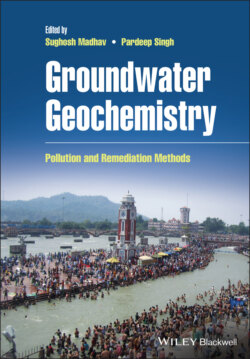Читать книгу Groundwater Geochemistry - Группа авторов - Страница 27
1.6.1 Iron
ОглавлениеIron is the second‐most abundant metallic element in the Earth's outer crust, but its concentration in water is usually low. It occurs in many oxidation states, such as 0, +2, +3, and +6. Many mixed‐valence compounds, like magnetite and prussian blue, have both Fe (II) and Fe (III) centres (Hashim et al. 2011). Igneous rock minerals such as pyroxenes, the amphiboles, biotite, magnetite, and especially the nesosilicate olivine are rich in iron content. In these minerals, iron mostly exists in the ferrous form (Fe3+) but ferric (Fe3+) form also occurs, as in magnetite, Fe3O4. The ferrous polysulfides like pyrite, marcasite, and the less constant species such as mackinawite and greigite might exist in the presence of sulphur and when reducing conditions prevail. Siderite (FeCO3) may form when sulphur is less plentiful, whereas under oxidizing environments, ferric oxides or oxyhydroxides species like haematite, Fe2O3, goethite, FeOOH, or other minerals having these compositions generally occur (CGWB 2014).
In soil, it is commonly present in organic waste and as plant debris. The oxidation intensity and pH firmly control the chemical nature of iron and its solubility in water. The interaction amid oxidized iron minerals and organic matter or dissolution of FeCO3 leads to a higher concentration of iron in groundwater. This type of water is clear when withdrawn, but soon it becomes cloudy and then browns due to precipitation of Fe (OH)3 (Hashim et al. 2011; Achary 2014a). Organic matter removes the dissolved oxygen within the sediments which creates reduced conditions in which iron‐bearing minerals (siderite/marcasite) has higher solubility causing enriching of the dissolved iron in the groundwater (Applin and Zhao 1989).
The dissolution of Fe in groundwater strongly depends on the concentration of dissolved oxygen and also on the pH of the water to a lesser extent. In groundwater, it generally occurs in two forms as Fe2+ and as Fe3+. Iron occurs as Fe3+ when the concentration of dissolved oxygen in groundwater is greater than 1–2 mg/L and as Fe2+ when dissolved oxygen is in low concentration. At normal pH of water, Fe2+ is soluble, and Fe3+ is insoluble. At low pH and dissolved oxygen, iron (also manganese) will dissolve readily in groundwater. Aquifers having higher depth and rich in organic matter typically contain less dissolved oxygen. Decomposition of the organic matter leads to depletion of the oxygen in the water, which results in the dissolution of the iron as Fe2+. In the oxygen‐deprived water, when pumped to the surface, a rust‐coloured iron mineral forms due to the reaction of dissolved iron and the oxygen (CGWB 2014).
In India, groundwater from a large number of areas is highly contaminated with iron. These areas include west Bengal, Rajasthan, Orissa, Goa, Haryana, Jammu and Kashmir, Andhra Pradesh, Karnataka, and Kerala (Garduño et al. 2011). Higher Fe constituent in the coastal aquifers may be due to the interface of oxidized Fe minerals and organic matter and subsequent dissolution of Fe2CO3 at a moderately lower pH.
The brown colour of groundwater after extraction from the aquifers is the primary sign of iron presence. The high concentration of Fe in water causes awful taste, staining, turbidity, and equipment problem in the water supply.
